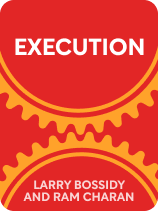

This article is an excerpt from the Shortform book guide to "Execution" by Larry Bossidy and Ram Charan. Shortform has the world's best summaries and analyses of books you should be reading.
Like this article? Sign up for a free trial here .
What are the functions of a leader? What are some of the common mistakes leaders make?
According to business leaders and specialists Larry Bossidy and Ram Charan, a leader must perform three functions to be successful. A good leader will find and keep talent, set realistic goals, and create tactical plans that work.
Here’s an overview of the functions of a business leader.
Main Leadership Function #1: Find, Retain, and Develop Top Talent
What are the functions of a leader? The first one is the ability to build a strong team. In their book Execution, Bossidy and Charan say that having high-quality talent always gives your company a strong competitive advantage. The skills and decision-making abilities of your people will either hinder or advance your company’s success. But businesses don’t always succeed in finding top talent.
Let’s discuss why businesses often choose the wrong people for leadership roles. Then, we’ll explore three elements of finding skilled team members and keeping them for the long term:
- Choosing the right people
- Keeping people accountable and making them better
- Safeguarding against shortages of talent
Why the Wrong People Get Chosen for Leadership Positions
Leaders make several common mistakes when they seek new talent or promote people to new positions. First, they use traditional interviews, which are insufficient. These interviews, say Bossidy and Charan, typically focus on a candidate’s intellectual prowess and educational attainments. Given that focus, traditional interviews grant an advantage to the person with impressive credentials, but the motivated, less flashy go-getter might be the better fit. Furthermore, traditional interview questions don’t tap into key qualities needed to lead well, like the ability to teach and inspire others or make quick, thoughtful judgment calls.
The second common mistake leaders make when hiring is relying on recommendations from their direct reports that don’t take the job requirements into account. A junior manager might say, “Jo sets a fantastic example for the whole team. She shows up early, asks smart questions, and goes out of her way to contribute.” These general qualities might make Jo great in her current role, but she may be totally unqualified for leadership. Bossidy and Charan advise that you assess each proposed candidate, above all else, against the skills needed for the job.
Third, leaders can’t bring themselves to say no or deliver bad news. As a result, they keep nonperformers on board way too long and elevate underperformers who aren’t ready for more responsibility. This, the authors caution, can demoralize people who are performing and cause real harm to the company.
How to Choose the Right People
So how can you avoid these pitfalls and trust that you’re selecting the right people for the right jobs? First, Bossidy and Charan suggest, engage in interviews that dig beneath the surface of education, industry knowledge, and past achievements. Ask questions like “If you knew your division would not meet sales goals this quarter, what steps would you take?” or “How do you foster collaboration and open communication among your team members?” This will give you insight into how the candidate makes decisions and how well they will fit into your company culture.
Second, have in-depth conversations with at least two references who you trust to tell you the truth—not only about what someone accomplished but also about how they did it and the skills they used. Pose questions such as “How would you describe their management style?” “Did they nurture their direct reports or alienate them?” “When their department surged in revenue, did that come at the expense of another department?” The authors explain that the answers to such questions will shed light on a candidate’s strengths and weaknesses, as well as the extent to which they prioritize their career growth over company goals.
Third, assess candidates’ work efforts and outcomes. This partly involves reviewing measurable results a candidate produced, such as revenue generated and the number of sales completed. But go beyond quantifiable metrics to also assess their interpersonal skills and adaptability. Bossidy and Charan advise you to consider a candidate’s energy, engagement, and ability to manage a high workload.
How to Keep People Accountable and Support Their Development
Once you’ve selected the right people for your team, it’s your job as the leader to both hold them accountable and ensure they are continually improving. As Bossidy and Charan remind us, accountability and constant improvement keep everyone making progress toward the goals that matter.
To hold people accountable and ensure their improvement, follow these steps:
Step #1: Make sure everyone is clear about the outcomes every team member is responsible for, their priorities, and the short-term benchmarks they’re expected to hit. That way, say Bossidy and Charan, people can coordinate their efforts to reach the targets that support long-term goals.
Step #2: Follow up rigorously with people in leadership roles so you stay informed about their progress and challenges. Regular check-ins give you an opportunity to offer support, detect risks on the horizon, and adjust plans accordingly.
Step #3: Have candid performance reviews with direct reports. Clarify what’s working, what’s not working, and what needs to improve—and make sure this is a two-way conversation so you get a clear picture of the challenges and opportunities in play. Then, send a memo after each review that documents any agreements you made during the meeting, next steps, and when the next check-in will be. This, Bossidy and Charan underscore, eliminates confusion about who’s doing what by when.
Step #4: Reward people who deliver results and withhold rewards from people who fail to meet expectations. This will reinforce the standards you’ve set and incentivize people to optimize their performance.
Safeguard Against Talent Shortages
Unfortunately, you can never guarantee that the talented people you hire will stay or develop as you thought they would. This can lead to staffing shortages, when team members either leave the company or get fired. Let’s examine some risks that could leave you vulnerable to staffing shortages and ways you can mitigate those risks.
Risk #1: Not having enough qualified people lined up to succeed current leaders—To manage this risk, Bossidy and Charan advise you to have solid talent development plans in place. This will give you a constant stream of internal candidates who can step into roles.
Risk #2: Vacant positions due to unexpected departures of key staff—Look out for red flags that someone might be inclined to leave. The authors recommend considering factors such as how marketable someone is to potential recruiters, their potential, and how long they’ve been stagnant in the same position. Also, assess whether people have been adequately rewarded for their contributions. If you spot any red flags, consider how you could entice the person to stay.
Risk #3: Not having people with the skills needed for the company’s next stage of growth—Your staff might be performing their current roles well, but that doesn’t mean they’re equipped to handle increased responsibilities following growth, such as a higher sales volume or launching a product overseas. Bossidy and Charan urge you to anticipate what skills you’ll need next quarter or next year, and be proactive in having qualified people ready to fill those roles.
Risk #4: Letting poor performers linger—Keeping poor performers on board in their current positions can destroy morale, sabotage the business, and send high performers running. Explore all options to eliminate this risk on a case-by-case basis. The authors suggest putting poor performers on a development plan, moving them to another position, or firing them. While all of these options can be emotionally challenging for both leader and subordinate, they’re necessary to keep your company strong.
Main Leadership Function #2: Set Realistic Goals
Once you have the right people in the right jobs at your company, the authors say it’s critical that you define goals that are grounded in reality and not just pie-in-the-sky aspirations. This involves creating a good strategic plan that will set your company in the most promising direction. Let’s look at the elements of a good strategic plan and how to finalize your plan so people stay connected to their part in fulfilling it.
Create a Strategic Plan That Makes Sense
A strategic plan outlines the future direction of a company and establishes its most important priorities and goals. As Bossidy and Charan note, leaders often neglect to do sufficient research before creating their strategic plan. They put together proposals based on secondhand reports, surface observations, and their emotions, then get frustrated when the outcomes fall far short of their targets.
It’s essential, say the authors, to base your strategic plan on grounded knowledge of your company’s true capabilities and resources, its strengths and weaknesses, risks in the external environment, insights on competitors, and the state of the market as a whole.
Further, create a strategic plan that functions as a loose framework for action, not a rigid formula. A good plan, Bossidy and Charan state, allows room for adjustments over time. You need to know what direction you’re heading in, but resist the urge to fill in specifics. For example, maybe you plan to cut costs, and you initially consider doing so by moving plant operations overseas—you don’t yet commit to that specific course, though. When a competitor does the same a few months later, they get horrible press coverage and their clients flee. Instead of going down the same path, you have a chance to adjust. How else can you cut costs? And how can you capitalize on your competitor’s stumble?
As you craft your strategic plan, cut out the fluff. Bossidy and Charan emphasize that you should be able to capture your strategy on a single page. If you can’t do that, go back and simplify. Identify the top two or three goals that your company is going to prioritize this year. Everything else should fall under those big goals.
Lastly, make sure the people who will be responsible for implementing the strategy are involved in creating it. Throughout the strategy sessions, invite and encourage people to speak freely about challenges they anticipate, resources they’ll need, and opportunities they see. Bossidy and Charan explain that this decreases the chances of being blindsided by a problem down the road. The process also builds buy-in and ownership from the key players. When they’re involved in creating a plan, they’re more invested in seeing it through. And bringing together the key players strengthens relationships across the company and fosters collaboration. Even when people disagree—which they will—the process of finding a solution is instructive and useful.
Wrap Up, Summarize, and Monitor Progress
When you meet with your team to finalize the creation of the strategic plan, make sure people leave with a clear picture of what they’re accountable for. Then, Bossidy and Charan advise, follow up by sending a memo to each leader that lays out their individual goals, commitments, priorities, and next steps. Thereafter, assess progress at regular intervals and make adjustments as needed.
Main Leadership Function #3: Create Tactical Plans That Work
By this point, you know how to find the right people for your company and create realistic big-picture goals. Next, you’ll learn how to translate your strategy into reality using a tactical plan. We’ll discuss the factors that make a tactical plan work well and the basic steps to follow when putting it together.
The Key Elements of a Tactical Plan
Your tactical plan specifies both short-term and long-term goals aligned with your strategy and describes how you’re going to reach those targets. Bossidy and Charan explain that it includes the major programs and projects that are lined up for the coming year, such as a new marketing initiative, a product release, or a sales force reconfiguration.
There is no strict formula for creating a tactical plan. It requires deep engagement, rigorous truth-telling, critical thinking, and much give-and-take between team members. That said, the general flow in creating your tactical plan, according to Bossidy and Charan, is fairly straightforward. Implement the following steps to create a plan that is ambitious and realistic—and that facilitates learning and relationship-building with key players in your company:
Step #1: Give leaders from each segment of the company the big-picture targets (for example, revenue and operating margin). Then, let each leader develop a tactical plan for their particular division to help the company reach those targets.
Step #2: Convene everyone to stress-test the assumptions built into each plan. For example, if you increase prices, will it turn customers away? Is demand for this product merely a short-term trend, or is it worth additional investment? The authors instruct that you—as the leader—must engage everyone by asking pointed questions to determine what’s most likely to produce the intended outcomes.
Step #3: Revisit and adjust plans based on how they fit with every other part of the company. Bossidy and Charan explain that everyone must constantly assess what give-and-take is necessary in the pursuit of big-picture goals. Devoting attention and resources to one opportunity or business unit inevitably comes at the expense of another. For instance, if you allocate additional resources to your European market, then you need to cut expenses elsewhere. Does it make more sense to do that in your North American market or your Asian market? After this vigorous back-and-forth discussion among the key players, the basic tactical plan is set.
Step #4: Identify contingency plans that can accommodate shifting circumstances. For example, if the European market goes cold, you’ll need to make up that anticipated revenue another way. Where will it come from? Robust contingency plans, Bossidy and Charan contend, can accelerate decision-making and help you avoid costly delays.
Step #5: Wrap up discussion and secure commitments from everyone to ensure alignment with the tactical plan.
Step #6: Follow up after the meeting with the key players, just as with the strategic plan. The authors recommend sending a memo that summarizes each person’s commitments and short-term benchmarks.
Step #7: Assess progress toward those benchmarks at quarterly review meetings.

———End of Preview———
Like what you just read? Read the rest of the world's best book summary and analysis of Larry Bossidy and Ram Charan's "Execution" at Shortform .
Here's what you'll find in our full Execution summary :
- What execution in business is and why it matters
- The three core functions that leaders must perform to execute well
- The three important qualities leaders must have to execute well






